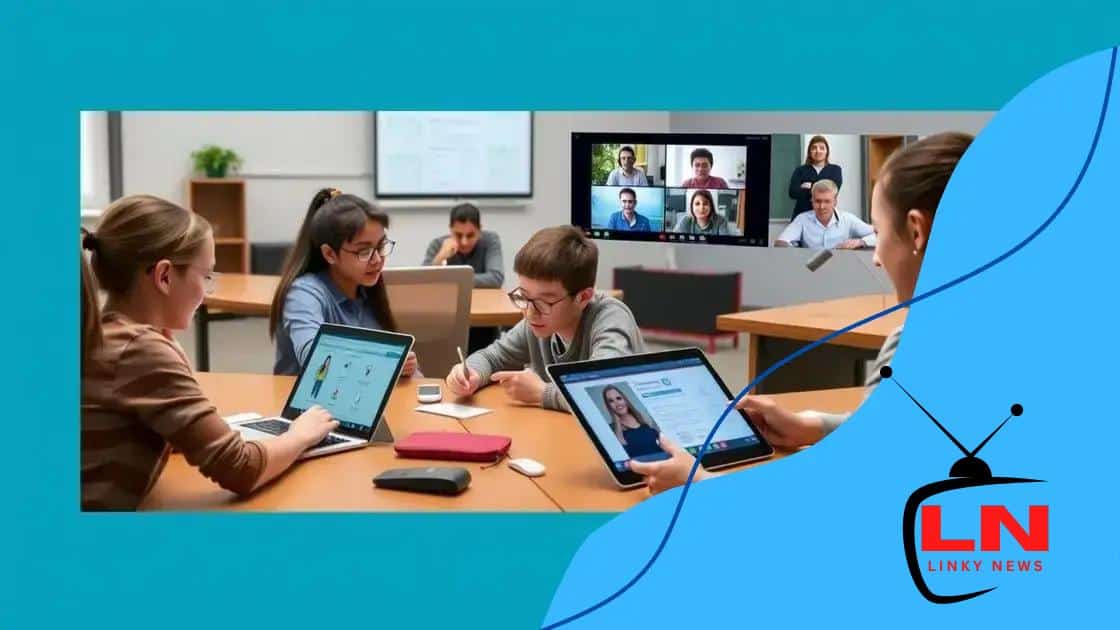The impact of virtual classrooms on student collaboration

The impact of virtual classrooms on student collaboration includes enhanced communication and teamwork through technology, while also presenting challenges such as technical difficulties and feelings of isolation among students.
The impact of virtual classrooms on student collaboration is more profound than many people realize. Have you seen how technology enables students to connect like never before? In this article, we explore the benefits and challenges faced in this evolving educational landscape.
Understanding virtual classrooms
Understanding virtual classrooms is essential in today’s educational landscape. These online environments have transformed traditional education, allowing students to connect and learn from anywhere in the world. By utilizing technology, schools create dynamic spaces for learning that promote interaction and collaboration.
In a virtual classroom, students participate in live lessons through video conferencing tools. This format enables students to ask questions in real time, fostering a more engaging learning experience. The absence of geographical barriers means that classrooms can be filled with a diverse group of students, enriching discussions and perspectives.
Key Features of Virtual Classrooms
Some important features that enhance the learning experience include:
- Interactive Tools: Features like polls and quizzes for instant feedback.
- Collaboration Software: Tools like shared documents and discussion boards for team projects.
- Accessibility: Resources available anytime and anywhere, accommodating different learning styles.
The benefits of these features extend beyond just the classroom setting. Students learn to communicate effectively in a digital age, preparing them for future career paths where such skills are vital. Additionally, teachers can utilize various multimedia resources to enhance lessons, making them more engaging.
As we explore how virtual classrooms impact education, it’s important to consider how they can foster a sense of community among students. Many platforms include discussion forums that allow students to share ideas and support each other, mimicking the social experience of a traditional classroom.
Virtual classrooms also present challenges, such as ensuring that students remain engaged and motivated. Educators must adapt their teaching methods to keep the online environment stimulating. Moreover, some students may face technical difficulties that hinder their participation. Thus, understanding the intricacies of virtual classrooms is crucial for both teachers and learners.
Increased peer interaction through technology
Increased peer interaction through technology has transformed the way students collaborate in virtual classrooms. This interaction encourages students to share ideas, ask questions, and support one another, creating a vibrant learning community. Online tools facilitate this communication, making it easier to connect with classmates.
Online platforms often feature chat rooms and discussion boards, where students can engage in lively conversations. Virtual classrooms provide real-time communication, allowing for immediate feedback and discussion. This dynamic creates a feeling of connection, even when students are physically apart.
Benefits of Peer Interaction
There are many benefits to increased peer interaction:
- Enhanced Learning: Students learn from each other’s perspectives, deepening their understanding.
- Support Systems: Collaborative environments foster friendships and support networks.
- Improved Communication Skills: Students practice articulating their thoughts clearly.
- Motivation: Peers encourage each other, increasing engagement and enthusiasm.
This interaction is especially important in a digital environment where some students may feel isolated. By encouraging communication and collaboration, virtual classrooms help diminish feelings of loneliness. Different technologies, like video conferencing, let students work together on projects and engage in discussions as if they were in the same room. This enhances the overall learning experience.
Additionally, with tools for group projects, students learn how to navigate technology together. Many platforms allow for shared documents and brainstorming sessions, making collaboration seamless. Engaging in group activities not only improves academic performance but also helps students develop essential life skills.
Collaborative tools and their effectiveness

Collaborative tools play a vital role in enhancing learning experiences in virtual classrooms. These tools help students work together, share resources, and build knowledge as a team. By utilizing technology, educators can create engaging environments that support collaboration and communication.
One of the most effective collaborative tools is shared documents. Platforms like Google Docs allow multiple users to edit the same document in real-time. This feature encourages active participation and makes it easier to complete group assignments. Students can comment on each other’s work, providing immediate feedback and suggestions.
Types of Collaborative Tools
Several types of tools foster collaboration:
- Video Conferencing: Platforms like Zoom and Microsoft Teams enable live discussions, making remote learning feel more personal.
- Project Management Tools: Applications like Trello and Asana help organize tasks and deadlines, keeping groups on track.
- Discussion Boards: Forums allow students to pose questions and share ideas asynchronously, providing opportunities for reflection.
These tools improve the overall effectiveness of virtual classrooms by facilitating smooth interactions between students. As students work together, they develop critical skills like teamwork and problem-solving. Additionally, technology helps accommodate diverse learning styles, catering to students who may struggle in traditional settings.
Engagement is another key factor. Collaborative tools often make learning enjoyable, increasing student motivation. By using interactive platforms, educators are able to capture students’ attention and enhance their learning experience. Moreover, the ability to collaborate with peers fosters a sense of community, which is essential in a digital learning space.
Challenges in virtual collaboration
Challenges in virtual collaboration can impact the learning experience in virtual classrooms. While technology offers many benefits, it also presents obstacles that students and teachers must navigate. Identifying these challenges is crucial for improving online education.
One significant challenge is the issue of technical difficulties. Students may encounter problems with their internet connection, software glitches, or hardware malfunctions. These issues can disrupt lessons and make it hard for students to engage fully. When technology fails, it can create frustration and hinder the learning process.
Communication Barriers
Another common challenge is effective communication. In a physical classroom, body language and facial expressions can help convey messages. However, in a virtual setting, important non-verbal cues may be lost. This lack of clarity can lead to misunderstandings among students and between teachers and students.
To address this, educators can emphasize the importance of clear communication by:
- Encouraging Questions: Students should feel comfortable asking for clarification.
- Utilizing Visual Aids: Diagrams or presentations can enhance understanding.
- Providing Feedback: Constructive feedback helps improve future interactions.
Additionally, the lack of a physical presence can create a sense of isolation. Some students may feel disconnected from their peers, which can impact motivation and engagement. Building a community in a virtual classroom is essential for promoting collaboration. Educators should foster connections through group projects, interactive discussions, and social activities.
Time management is also a challenge in online learning. Without the structure of a traditional classroom, students may struggle to stay organized and meet deadlines. Developing time management skills is crucial for success in a virtual environment. Educators can help by providing clear timelines and setting expectations for assignments.
Future trends in student collaboration
Future trends in student collaboration are being shaped by advancements in technology and evolving educational practices. As virtual classrooms become more common, collaboration among students is likely to see exciting new developments. Innovating ways to work together can enhance learning outcomes and create an inclusive environment.
One significant trend is the integration of artificial intelligence (AI). AI tools can provide personalized learning experiences, allowing students to collaborate more effectively. These tools can analyze student performance and suggest tailored resources, enabling students to help each other based on their strengths and weaknesses.
Enhanced Virtual Reality (VR)
Enhanced virtual reality (VR) is another promising trend. With VR, students can engage in immersive learning experiences where they collaborate in simulated environments. This technology allows them to work on projects as if they were in the same physical space, fostering teamwork and real-life problem-solving skills.
Collaborative platforms are also expected to evolve. Online tools will likely become more sophisticated, providing features like real-time language translation and enhanced communication options. This will enable students from diverse backgrounds to work together seamlessly, making collaboration easier and more effective.
- Gamification: Incorporating game elements into collaborative tasks can motivate students and make learning enjoyable.
- Flexible Learning Environments: Hybrid models will allow students to work together both online and offline, promoting adaptability.
- Focus on Social-Emotional Learning: Emphasizing emotional intelligence will help students build relationships and empathy.
The shift towards project-based learning will also define future collaboration. Students will engage in hands-on projects that require teamwork and communication. This approach prepares them for real-world scenarios where collaboration is key to success.
As we look into the future, it is clear that student collaboration will continue to evolve. These trends not only enhance the learning experience but also prepare students for a world that increasingly values teamwork and connectivity.
FAQ – Questions about the impact of virtual classrooms on student collaboration
How do virtual classrooms enhance student collaboration?
Virtual classrooms use technology to connect students, allowing them to work together on projects and share ideas in real-time.
What are some common challenges in virtual collaboration?
Common challenges include technical difficulties, communication barriers, and feelings of isolation among students.
What collaborative tools can be used in virtual classrooms?
Tools like Google Docs, Zoom, and discussion boards facilitate collaboration among students, making group projects easier.
What future trends can improve collaboration in virtual classrooms?
Future trends include the integration of AI, enhanced virtual reality experiences, and advanced collaborative platforms for seamless teamwork.





